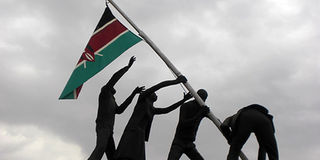A symbol of our independence

What you need to know:
- December 12, 1963, was a special day for Kenya. Today, one of Nairobi’s parks stands as a living reminder of what that day means to us.
The Republic of Kenya will be marking 48 years of self-rule on Monday. What are your plans for the day? How about a walk back in history where it all begun ...the Uhuru Gardens Memorial Park?
Many moons ago, on December 12, 1963, at midnight to be exact, throngs of Kenyans were elbowing each other for viewing space on the grounds of the Uhuru Gardens.
It was not just a grand day; it was remarkable. Most of those in the crowd had seen the worst of the independence struggle: the disorder, heartache and loss it had caused.
Many had paid for this day with their lives – harbouring dreams of witnessing such celebrations when they took up weapons for love of country. For those who survived it, it was nothing short of a spectacle to behold.
Arrivals to the Gardens had begun very early and one could smell the dreams, anticipation, joy, excitement and hope of a new beginning in the air. It was the sweetest aroma!
When the Union Jack was finally lowered for the last time at midnight, this building exhilaration boiled over to unparalleled euphoria as people turned to one other in tears, hugs, dance and whoops of joy, in what could only be termed as borderline delirium – but of the good kind.
National monuments
Today, the park rests quietly on the busy Lang’ata Road in Nairobi, its tag of importance buried amidst the busy Wilson Airport and the ever-growing Lang’ata neighbourhood.
Covering 76 acres, it is the largest memorial park in Kenya and carries its distinct landmarks with pride.
One of this is the Uhuru Monument, the 24-metre high independence commemoration monument designed by the architect Hamid Mughal.
At the centre of the monument is a dove with an olive branch in its mouth, resting on clasped hands which are protecting a heart. This symbolises the Nyayo philosophy of peace, love and unity.
To the left is a sculpture of a man, chest jutting out in a brave stance, sculptured in front of the Coat of Arms. This is to symbolise that the people are ready to protect their country’s interests and resources.
On the right-hand side, the spirit of Harambee is captured in a statue of a group of people helping each other to raise the Kenyan flag.
That is not all. At the spot where the Kenyan flag was erected for the first time on that day stands a large Mugumo tree planted in tribute to this.
During the celebrations to mark 25 years of independence, another fountain monument was added to the Gardens, about 100 metres from the Uhuru Monument.
New status
Plans are underway to erect a national monument in honour of the country’s past and present heroes and heroines at the Mashujaa Square, an area sectioned off within the gardens.
The Gardens are much more than a green space in the capital. This is where our status as a republic was stamped before the whole world.
As Kenyans, we were finally vindicated to stand up in a crowd and raise our flag high, sing our National Anthem, pursue the Kenyan dream and stand up for our country, shortcomings notwithstanding.
Additionally, one must stop to think of the significance of all these monuments in present-day Kenya. The principles of peace, love, unity and harambee are timeless and are like a muscle that constantly needs to be worked if it is to show any signs of good form.
Far be it from me to make this a political read, but, isn’t it time you thought about what your contribution has been towards working this muscle?
Well, you can pack your loved ones and a picnic, along with your thinking cap, this Jamhuri Day.




